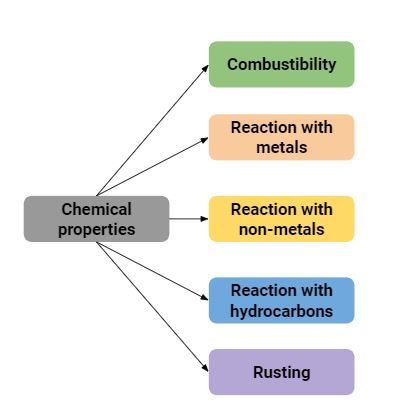PDF chapter test TRY NOW

Combustibility:
Oxygen does not burn on its own. So, it is a non-combustible gas. It supports the combustion of
other substances.
Do you know?
If oxygen can burn itself, striking a match stick is enough to burn all the oxygen in the atmosphere of our planet.
Reaction with metals:
Oxygen reacts with metals to give their corresponding metal oxides. These are basic in nature. But the reactivity of metals differs towards oxygen.
Where, X is a metal.
X = \(Na\), \(K\), \(Mg\), \(Ca\), \(Fe\), \(Cu\), \(Ag\), \(Au\), \(Pt\), etc.
| Temperature | Reaction with oxygen (\(O_2\)) |
| At room temperature | |
| Slight temperature | |
| At high temperature |
You may wonder by the fact that the number of atoms in the reactant (on the left-hand side) and product (on the right-hand side) are unequal. This is known as an unbalanced equation.
What should be done to balance them?
To balance the chemical equation, we need to make sure the number of atoms on the reactant side is equal to the number of atoms on the product side. To make both sides equal, multiply the atoms in each side until they are equal on both sides.
Reaction with non-metals:
Oxygen reacts with various non-metals to form corresponding non-metallic oxides. They are generally acidic in nature.
X is non-metal.
X = \(C\), \(N\), \(S\), \(P\), etc. These non-metals react with oxygen to give their respective oxides as shown below:
Reaction with hydrocarbons:
Hydrocarbon means a compound containing carbon and hydrogen that react with oxygen to form carbon dioxide and water vapour.
Example for hydrocarbon: Wood, petrol, diesel, LPG, etc.
When hydrocarbons burn in oxygen, they produce heat and light energy; hence, they are good fuels.
Rusting:
The conversion of iron into its hydrated form of oxide in the humid atmosphere (humid atmosphere is the amount of water vapour in the air) is called rusting. Hydrated ferric oxide is rust.
Where, X is a variable that denotes the number of water molecules.
